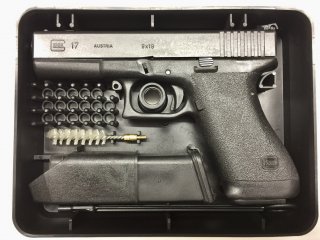How the Glock Became an American Powerhouse
Even those who know guns probably don't know this.
Here's What You Need to Remember: This brand got its start at the same time as Beatlemania.
Thanks in no small part to movies such as Die Hard II even people who don't know firearms know Glock, the Austrian firm best known for its polymer-framed pistols. What most don't know is that the company was only founded in 1963, yet today produces more than two dozen models of handguns in three sizes and seven different cartridges in three calibers.
That’s not bad for a brand that got its start at the same time as Beatlemania.
And even those who do know firearms, still likely don't know all that much about Glock, which isn’t actually the manufacturer but rather the product that is made by the Austrian firm Glock Ges.m.b.H. The company may be known for its firearms, but it also produces field knives, entrenching tools and apparel.
Long before its founder Gaston Glock ever decided to produce the Glock 17, the company's first handgun, he started by making household products including curtain rods and later knives. While prolific firearms designer John Browning received his first patent for a firearm in his 1920s, Gaston Glock was fifty-two years old before he developed a firearm.
In the 1970s Gaston Glock developed grenade castings and machine-gun belt links, and as an expert in polymers he began to use the materials to make knife handles and sheaths. Then in the early 1980s, he decided to see how polymers could be used in the production of a handgun. The result was the semi-automatic Glock series pistol, and it featured a polymer frame—which soon led to concerns about the “plastic gun” that some believed (even before Die Hard II) could get past airport X-ray machines.
However, the Glock 17 passed the strict NATO durability test and was selected by the Norwegian Army as its standard sidearm. That put the company and its unique handgun on the road to become the preferred international law enforcement sidearm. While the U.S. military adopted the Beretta M9 to replace the aging Colt M1911 .45 pistol, various Glocks have been the preferred weapon for Special Forces including the U.S. Navy SEALs.
Moreover, the USMC followed by adopting the Glock 19M as the “M007 Concealed Carry Weapon” in 2016 for those Marines who had a need for a compact pistol—such as criminal investigation units and the crews of the HMX-1 helicopter squadron.
Today, if there is a complaint about Glock it is that the handgun models can be downright confusing—instead of being named for the year or caliber, the company names the product for the next patent number. Hence the first Glock handgun was dubbed the Glock 17 not because it held seventeen rounds in the magazine, but rather because it was named after number patented by Gaston Glock during the development of the pistol. While that might seem reasonable for the day, especially for an inventor who also created field knives and a folding shovel, it has created confusion for gun owners today especially considering that the company has produced dozens of models.
The other big complaint is that some models aren't available in the U.S. for commercial sale. This has included the Glock 18, a full-sized nine-millimeter "automatic pistol" that can be fired like a submachine gun with a rate of fire of 1,200 rounds per minute. Yet, other handguns such as the Glock 25 and Glock 28, which each fail to meet the ATF's criteria for importation.
However, even if a select few Glocks can’t be imported, the company has shooters covered by offering its polymer-framed handguns in numerous calibers and sizes. It’s a good thing old Gaston didn’t decide to stick with curtain rods.
Peter Suciu is a Michigan-based writer who has contributed to more than four dozen magazines, newspapers and websites. He is the author of several books on military headgear including A Gallery of Military Headdress, which is available on Amazon.com.
Image: Wikimedia

